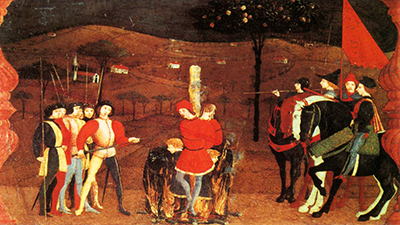This Renaissance painting is notable in several respects. We should note that it's a tempera on panel work. Tempera is a fast-drying paint consisting of pigments bound by a material like egg yolk.
Paolo Uccello painted this scene on a wooden surface or panel. It's part of a commissioned work which was a six-part series. The painting shows scenes from a story which had captured popular imagination at the time and place. The Confraternity of Corpus Domini had commissioned this work. This organisation promoted devotion to the Eucharist. That's the sacramental bread which is central to Catholic worship.
This painting, the fifth in a series of six, reflects the anti-Semitism which was rampant in 15th century Europe. The Jewish diaspora had an uneasy relationship with its Christian neighbours. Jews had settled in Europe after exile from Israel, the traditional Jewish homeland. People rarely socialized outside community, so there was no concept of oneness in diversity. Other communities were feared and dreaded. The Christian Bible clearly states the Jewishness of Jesus Christ and the status of Jews as God's chosen people. Yet Christians continued to view the Jews with suspicion.
This painting shows the brutal execution of a Jewish family. The alleged crime was desecrating a Eucharistic host. This painting shows the suspicion and intolerance which pervaded at the time. Such a painting would be unacceptable today. But it gives a valuable lesson to today’s world. It shows how far hatred and intolerance can go. It's also a good example of the tempera on panel painting. The work is now housed in the gallery of the Ducal Palace in Urbino.
Paolo Uccello was a 15th century painter and mathematician. He created some pioneering art work. He's known for tempera on panel paintings. He worked in Florence and studied art with Lorenzo Ghiberti, the legendary Florentine sculptor. Like a typical Renaissance artist, Paolo Uccello didn't restrict himself to his art, but explored other areas too. No doubt, his proficiency in mathematics gave him a feeling for precision and measurement, which is reflective in his art. This can be seen to the present day. Religious organisations commissioned much of his work. This could be reason why it features different religious themes.




